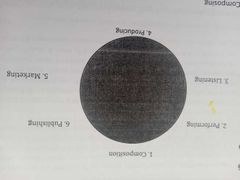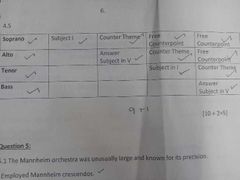![]()
![]()
![]()
Use LEFT and RIGHT arrow keys to navigate between flashcards;
Use UP and DOWN arrow keys to flip the card;
H to show hint;
A reads text to speech;
47 Cards in this Set
- Front
- Back
|
Processes of music |

|
|
|
Transecriprion |
Made if a score is written down of a live recording or performance without any changes |
|
|
Arrangements |
Reorganising the material of an existing piece with a different purpose than originally intended without damaging it's essence |
|
|
Any performance must have or consist of: |
-A source -An intention -An execution |
|
|
Publishing music processes |
-Commissioning new music -Copyrighting -Typing the scores -Editing the scores -Binding the music |
|
|
Cantus Firmus(firm voice) |
Gregorian Chant where melody is sung in the lower voice while one or more voices are sung against the melody(descant) |
|
|
Notre Dame school - Ars Antics(Old art) and 2 composers |
Music of the school played in Paris. 2 most famous composers are Leonin, Perotin |
|
|
Notre Dame school - Ars Nova(New Art) |
Church music with measured time(strict rhythm). Famous composer: Guillaumme de Machaut |
|
|
Traveling musicians of 13th century performing songs ballads and poetry |
-Troubadours -Trouveres |
|
|
Later these travelling musicians included other artists in their groups |
Acrobats, magicians, jugglers: Minstrels |
|
|
Middle age dances |
Estampie - triple metre, trong fast beat
Pavane - slow
Galliard - quick |
|
|
Sacred forms in Renaissance |
Motet: Most important polyphonic vocal music in Middle ages and Renaissance. From Renaissance onwards it has a Latin Sacred text and sung during Catholic services
Masses: Polyphonic choral work with 5 sections with a FIXED Latin text and is used for the liturgy of the Roman Catholic church service
|
|
|
The 5 Mass sections |
Kyrie Eleison: God have mercy Gloria in excelsis Deo: Glory to God in the highest Credo: I believe in one God Sanctus: Holy Angus Dei: Lamb of God |
|
|
Madrigal |
Secular text in vernacular language |
|
|
Marketing |
-Marketing because easier with recorded music -Recordings of popular music accomplished this -Most marketing takes place on Radio, film and television -Live performance -Through internet and phones |
|
|
Why did Church music dominate the Middle ages |
Church music was the only music notated |
|
|
Dates of stages of baroque period |
Early: 1580-1630 Middle: 1630-1680 Late: 1680- 1750 |
|
|
How does the composer create unity in a Mass |
Using existing material in all the parts of the Mass - Based on a plainchant -Based on secular melodies -Based on original themes -Based on a complete composition |
|
|
Characteristics of rococo period |
-Noble simplicity -Calm grandeur -Following ideals of classical Rome and Greece -Art and architecture was characterised by delicacy, elegance and wit -The structure of the music is clear and balanced, firm musical lines |
|
|
State 2 types of recitativo in the Baroque |
-Recitativo Secco -Recitativo Accompagnato |
|
|
Characteristics of the Oratorio |
Sacred counterpart of the opera, originates in Rome - No action, decor or costumes - The story is always biblical (told by narrator) - The chorus becomes a significant part of the Oratorio due to its dramatic potential -Arias, recitatives, vocal ensembles and instrumental sections are also used |
|
|
5 principals the Camerata suggested that serve as good foundation for composing an opera(Baroque period) |
-Music must be dutiful to text and meaning -Polyphony and counterpoint are unsuitable for expression and emotions -A single melody with sparse chordal accompaniment is suggested as alternative -Setting of text must follow the rhythm and metre closely and the melodic curve must follow the natural infection of the voice -The singer must perform the melody and text with feeling and expression |
|
|
List different treatments of the Theme and Variation Form |
-Ornamental treatment of melody -Change of harmony -Change of rhythm -Change of key -Imitation or fugal treatment -Placing melody in different voice -General elaboration of the whole by: -passing notes -syncopation -arpeggios |
|
|
Describe Early Baroque stage |
Instrumental: A split between vocal and instrumental Vocal: Effective setting of texts Texture: Use of counterpoint avoided Dissonance used freely Composer: Gabrieli Monteverdi |
|
|
Describe Middle Baroque stage |
Instrumental: Vocal and instrumental music equal
Vocal: Difference between aria and recitative. Bel Canto style develop
Texture: Counterpoint used freely
Composers: Schutz, Scarlatti |
|
|
Describe Baroque Late stage |
Instrumental music: Dominates vocal music Concerto style develops Idiomatic interchange between instruments Vocal: Large genres develop fully - Opera and oratorio Texture : Polyphonic Composers: Vivaldi, Handel |
|
|
5 contributions Mozart made to the concerto genre |
- German influence visible due to his arrangements of Bach's music -The improvised during performances -Orchestral parts in tutti have a symphonic sound but while accompanying the soloist it has chamber qualities - A New feeling of dramatic power was inspired by his operas |
|
|
Characteristics of the Da Capo Aria(Baroque period) |
- Texture homophonic - Accompanied by harpsichord with/without other instruments - Second A is embellished (ABA form) |
|
|
Cantata |
A setting of hymns in different combinations of voices, solo and choral. Can be secular or sacred |
|
|
Passion |
A setting of Christ's Passion according to the 4 gospels: Matthew, Mark, Luke, John |
|
|
Oratorio |
The storyline is always Biblical. Sacred counterpart to the opera |
|
|
Draw a schematic representation of the subject and various other entries of a standard four-voiced fugue |

|
|
|
Important composition by Palestrina |
Pope Marcellus Mass |
|
|
Martin Luther, name three sources from which he suggested that tunes should be adopted for congregational singing |
-Catholic melodies were translated into German -Secular songs were provided with sacred texts - New songs were composed |
|
|
Two composers from Mannheim school |
Carl and Johann Stamitz |
|
|
Name 2 Passions |
St. John and St Matthew Passion |
|
|
Three composers from the 1st Viennese School |
Haydn, Mozart, Beethoven |
|
|
Characteristics of Ritornello form |
- Based on alternations between tutti and solo - Tutti always open with the theme which is called a Ritornello(refrain) - This theme returns throughout the movement in different keys but only in fragments - Ritornello return in fully only at the end of the movement |
|
|
Describe the 3 part Handel Messiah and state the source of the libretto |
Part 1: The prophecy of the coming of the Messiah Part 2: Redemption of mankind Part 3: Certainty of eternal life through Christ. The Old and New Testament is the source of the libretto |
|
|
Main Characteristics Mozart's music |
-Graceful, balanced and in perfect proportion -Occasional hints of a darker mood -Lyrical melodies |
|
|
Mozart operas |
-The marriage of Figaro -Don Giovanni -Cosi fan Tutti -The Magic Flute |
|
|
Mozart: Don Giovanni |
-Blend of Opera Buffa(comic opera) and Opera Seria(serious opera) - It combines seduction and slapstick with violence and the supernatural -The opera is in 2 acts |
|
|
Mozart influence on the Symphony |
-Increase dramatic power -contrapuntal complexity -started exploiting the tone palette of the Mannheimers -His experience in chamber music, was transferred to symphony |
|
|
Mannheim school characteristic |
- unusually large ensemble known for precision and finesse - Employed Mannheim Crescendo - Mannheim sigh(leaning appoggiatura) - Mannheim rocket(upwards shooting triadic patterns) -Exploited tone quality of each instrument -Orchestra 45 players |
|
|
Trio Sonata |
-Sonata de Chiesa(church): Organ, cello, solo instruments -Sonata da Camera(Chamber): Harpsichord, Cello, Solo instruments |
|
|
Handel Messiah imagery of Shepard and Lamb features |
'He shall feed his flock' 'Behold the lamb' |
|
|
Messiah characteristics |
-Soloists dont dominate and chorus has a leading role -No dialog, narrating is done through sung text |

